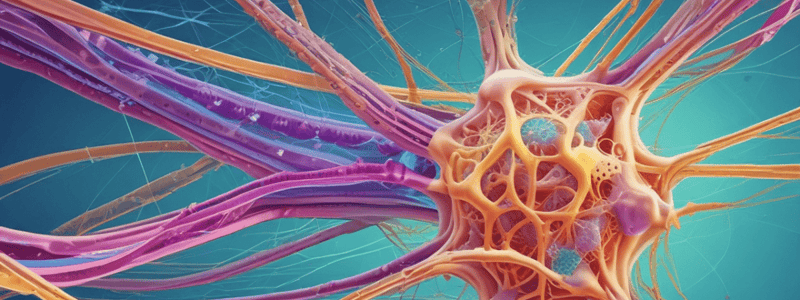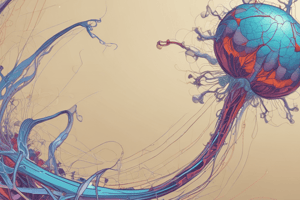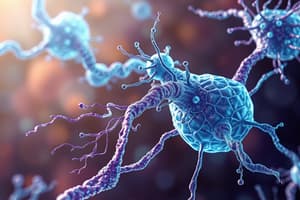Podcast
Questions and Answers
Microfilaments are hollow tubes that provide structural support and play a role in cell division.
Microfilaments are hollow tubes that provide structural support and play a role in cell division.
False (B)
The cytoskeleton is anchored to the nucleus through linker proteins.
The cytoskeleton is anchored to the nucleus through linker proteins.
False (B)
The cytoplasm plays a role in cell signaling by transmitting signals from the nucleus to the cell surface.
The cytoplasm plays a role in cell signaling by transmitting signals from the nucleus to the cell surface.
False (B)
Ribosomes are found in the nucleus and are responsible for protein synthesis.
Ribosomes are found in the nucleus and are responsible for protein synthesis.
Lysosomes are responsible for generating energy for the cell.
Lysosomes are responsible for generating energy for the cell.
The cytoskeleton plays a role in maintaining cell shape and mechanical strength but not in cell division.
The cytoskeleton plays a role in maintaining cell shape and mechanical strength but not in cell division.
The Golgi apparatus is involved in protein modification and transport, but not in protein synthesis.
The Golgi apparatus is involved in protein modification and transport, but not in protein synthesis.
The cytoplasm contains the necessary machinery for protein synthesis, including ribosomes, mRNA, and amino acids.
The cytoplasm contains the necessary machinery for protein synthesis, including ribosomes, mRNA, and amino acids.
Lysosome storage disorders are caused by the overproduction of lysosomal enzymes.
Lysosome storage disorders are caused by the overproduction of lysosomal enzymes.
Lysosomes are responsible for cellular digestion and recycling.
Lysosomes are responsible for cellular digestion and recycling.
Gaucher disease is a type of mucopolysaccharidosis.
Gaucher disease is a type of mucopolysaccharidosis.
Pompe disease is a type of glycoprotein storage disorder.
Pompe disease is a type of glycoprotein storage disorder.
Neuronal ceroid lipofuscinoses is a type of lipid storage disorder.
Neuronal ceroid lipofuscinoses is a type of lipid storage disorder.
Enzyme replacement therapy is a treatment option for lysosome storage disorders.
Enzyme replacement therapy is a treatment option for lysosome storage disorders.
Gene therapy is a well-established treatment for lysosome storage disorders.
Gene therapy is a well-established treatment for lysosome storage disorders.
Early diagnosis and treatment can improve outcomes and quality of life for patients with lysosome storage disorders.
Early diagnosis and treatment can improve outcomes and quality of life for patients with lysosome storage disorders.
Flashcards are hidden until you start studying
Study Notes
Cytoskeleton
- The cytoskeleton is a network of filaments that provides structural support, shape, and mechanical strength to the cell
- Composed of three main components:
- Microtubules: hollow tubes that provide structural support and play a role in cell division
- Microfilaments: solid fibers that provide mechanical strength and are involved in muscle contraction
- Intermediate filaments: provide structural support and play a role in maintaining cell shape
- Functions:
- Maintains cell shape and mechanical strength
- Plays a role in cell division, migration, and signaling
- Provides a track for motor proteins to transport organelles and molecules
Cell Membrane Interactions
- The cytoplasm interacts with the cell membrane through various proteins and lipids
- The cytoskeleton is anchored to the cell membrane through linker proteins, providing mechanical strength and stability
- The cell membrane regulates the flow of molecules in and out of the cell, and the cytoplasm plays a role in this process through endocytosis and exocytosis
- The cytoplasm also interacts with the cell membrane through signaling pathways, allowing for communication between the inside and outside of the cell
Cell Signaling
- The cytoplasm plays a crucial role in cell signaling pathways, which allow cells to respond to external stimuli
- Signaling molecules, such as hormones and growth factors, bind to receptors on the cell surface, triggering a response in the cytoplasm
- The cytoplasm contains signaling molecules, such as second messengers, that transmit signals from the cell surface to the nucleus
- The cytoskeleton also plays a role in cell signaling, providing a platform for signaling complexes to form
Protein Synthesis
- The cytoplasm is the site of protein synthesis, where messenger RNA (mRNA) is translated into a polypeptide chain
- Ribosomes, found in the cytoplasm, read the mRNA sequence and assemble amino acids into a polypeptide chain
- The cytoplasm contains the necessary machinery for protein synthesis, including ribosomes, tRNA, and amino acids
- The cytoskeleton plays a role in protein synthesis, providing a platform for ribosomes to bind and translate mRNA
Cellular Organelles
- The cytoplasm is home to various cellular organelles, including:
- Mitochondria: responsible for generating energy for the cell
- Endoplasmic reticulum (ER): involved in protein synthesis and transport
- Golgi apparatus: responsible for protein modification and transport
- Lysosomes: contain digestive enzymes and are involved in cellular recycling
- The cytoskeleton provides a platform for organelles to move and interact with each other
- The cytoplasm plays a role in regulating organelle function and interaction, ensuring proper cellular function.
Cytoskeleton
- Provides structural support, shape, and mechanical strength to the cell
- Composed of microtubules, microfilaments, and intermediate filaments
- Microtubules provide structural support and play a role in cell division
- Microfilaments provide mechanical strength and are involved in muscle contraction
- Intermediate filaments provide structural support and maintain cell shape
Cell Membrane Interactions
- The cytoplasm interacts with the cell membrane through proteins and lipids
- Cytoskeleton is anchored to the cell membrane through linker proteins, providing mechanical strength and stability
- Cell membrane regulates the flow of molecules in and out of the cell
- Cytoplasm plays a role in endocytosis and exocytosis
Cell Signaling
- Cytoplasm plays a crucial role in cell signaling pathways
- Signaling molecules bind to receptors on the cell surface, triggering a response in the cytoplasm
- Cytoplasm contains signaling molecules, such as second messengers, that transmit signals from the cell surface to the nucleus
- Cytoskeleton provides a platform for signaling complexes to form
Protein Synthesis
- Cytoplasm is the site of protein synthesis, where mRNA is translated into a polypeptide chain
- Ribosomes read the mRNA sequence and assemble amino acids into a polypeptide chain
- Cytoplasm contains the necessary machinery for protein synthesis, including ribosomes, tRNA, and amino acids
- Cytoskeleton provides a platform for ribosomes to bind and translate mRNA
Cellular Organelles
- Cytoplasm is home to various cellular organelles, including mitochondria, ER, Golgi apparatus, and lysosomes
- Mitochondria generate energy for the cell
- ER is involved in protein synthesis and transport
- Golgi apparatus is responsible for protein modification and transport
- Lysosomes contain digestive enzymes and are involved in cellular recycling
- Cytoskeleton provides a platform for organelles to move and interact with each other
Lysosome Storage Disorders
Definition
- A group of inherited metabolic disorders caused by lysosomal enzyme deficiency or malfunction, leading to toxic substance accumulation within lysosomes.
Characteristics
- Lysosomes are responsible for cellular digestion and recycling, and enzyme deficiency or malfunction causes undigested substrate accumulation.
- This accumulation leads to cellular damage, organ dysfunction, and progressive disease.
Types of Lysosome Storage Disorders
Lipid Storage Disorders
- Gaucher disease: glucocerebroside accumulation
- Niemann-Pick disease: sphingomyelin accumulation
- Fabry disease: glycosphingolipid accumulation
Mucopolysaccharidoses
- Hurler syndrome: mucopolysaccharide accumulation
- Hunter syndrome: mucopolysaccharide accumulation
Glycogen Storage Disorders
- Pompe disease: glycogen accumulation
Other Disorders
- Mucolipidoses: lipid and mucopolysaccharide accumulation
- Neuronal ceroid lipofuscinoses: lipofuscin accumulation
Clinical Features
Neurological Symptoms
- Developmental delay
- Seizures
- Intellectual disability
- Vision and hearing loss
Visceral Symptoms
- Hepatomegaly (enlarged liver)
- Splenomegaly (enlarged spleen)
- Cardiovascular disease
Skeletal Symptoms
- Bone deformities
- Joint pain and stiffness
Other Symptoms
- Respiratory problems
- Skin lesions
Diagnosis and Treatment
Diagnosis
- Enzyme assays
- Genetic testing
- Imaging studies (e.g., MRI, CT scans)
Treatment
- Enzyme replacement therapy (ERT)
- Substrate reduction therapy (SRT)
- Bone marrow transplantation
- Gene therapy (experimental)
Prognosis
- Variable depending on the specific disorder and severity of symptoms
- Early diagnosis and treatment can improve outcomes and quality of life
Studying That Suits You
Use AI to generate personalized quizzes and flashcards to suit your learning preferences.




